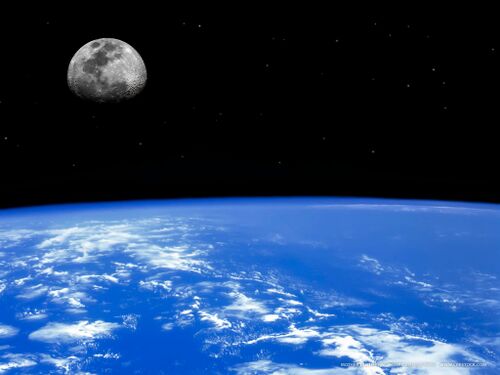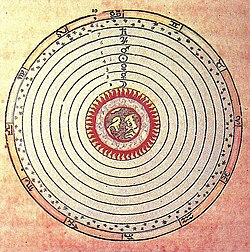Planet
| ||||||||||||||||||||||||||||||||||||||||||||||||||||||||||||||||||||||||||||||||||||||||||
An ancient Greek term meaning wandering star - as opposed to the backdrop of the fixed stars.
This term has different meanings in astronomy and astrology:
Astronomy
The two meanings started diverging after the Copernican revolution, which placed the sun at the center of our solar system and the term planet started to indicate a celestial body directly orbiting the sun. Planets reflect the sun's light, rather than being luminous themselves, and circle it along elliptical orbits. Their orbital period is determined by their distance from the sun: the further away they are, the longer their orbital period.
Numerous new celestial bodies have been discovered in our solar system since the beginning of the 19th century (asteroids, centaurs, the Kuiper Belt and many new discoveries can be expected in the future,) but very few added to the count of known planets, the others being classified as either dwarf planets or comets.
Until 2006 astronomers counted nine planets in our solar system: Mercury, Venus, earth, Mars, Jupiter, Saturn, Uranus, Neptune and Pluto.
Only Mercury, Venus, Mars, Jupiter and Saturn are normally visible from the earth with the naked eye. Although Uranus is occasionally visible unaided under ideal viewing conditions, and astronomer John Flamsteed classified it as a fixed star in 1691, William Herschel first noted its movement one century later. Galileo first observed Neptune in 1612, but thought it io be a moon of Jupiter. Neptune was classified as a planet in 1846. Pluto awaited discovery as a planet until 1930. Consequently the moon, sun, and the original "naked eye" planets were the only ones known to ancient cultures and traditional astrologers.
- Mercury and Venus are classified as inner planets because they orbit the sun within the earth's own orbit
- Mars, Jupiter and Saturn are classified astronomically as outer planets, with orbits outside of the earth's orbit
- Mercury, Venus, earth and Mars are similar in structure and size; Jupiter, Saturn, Uranus and Neptune are classified as giant planets
- Pluto is the only ice planet
Mercury, Venus and Mars all have smaller masses than the Earth, and the giant planets all have considerably larger masses. Jupiter's mass is 318 times that of the Earth, and Saturn's is 95 times as large. Pluto has the smallest mass of all nine planets. All planets apart from Mercury and Venus have at least one moon.
In 2006 the International Astronomical Union (IAU) introduced a new definition of planet, as a celestial body orbiting the sun that is large enough to be "round" and that does not share its orbit with other celestial bodies unless they are satellites. This definition does not hold for Pluto, so they reclassified it as a dwarf planet. Thus the count of known planets in our solar system is currently eight.
Astrology

Astrology classifies the planets differently than astronomy because its focus is different. Astrologers normally see the planets from a geocentric or earth-based perspective, rather than a heliocentric one, and keep the classical definition of "wandering star".
The sun and moon are counted as planets but normally the earth is not included because it is the location of the astrologer and horoscope native. Therefore, the seven classical planets in astrology are: sun, moon, Mercury, Venus, Mars, Jupiter and Saturn. Most modern astrologers also work with Uranus, Neptune, and Pluto for a total of ten planets.
These planets are divided into three groups: personal, social and spiritual or outer planets. The latter are Uranus, Neptune and Pluto, the social planets are Jupiter and Saturn and the five remaining planets are classified as personal planets. Astronomers' reclassification of Pluto as a dwarf planet in 2006 has not affected its status in modern astrology.
Some astrologers include additional celestial bodies in their work: the dwarf planet Ceres; major asteroids Pallas, Juno and Vesta; and the centaur Chiron enjoy increasing popularity.
All the planets except the sun and the moon are named after the Roman gods of Antiquity. Many astrologers attach significance to the myths associated with these gods. Of the seven classical planets the moon, Venus and sometimes Saturn were considered to be feminine; the sun, Mars, and Jupiter masculine; and Mercury hermaphroditic.
The planets, zodiac signs, aspects between planets, and houses form the basis for most astrological interpretation. The planets represent archetypal energies in humans which are additionally coloured by their position in the signs. The house position indicates the area of life in which these energies will be most strongly expressed.
Astrologers disagree about which model best explains the way astrology works: whether the planets have some kind of direct physical influence (causality) or whether they are only indicators (in the way that the hands of a clock indicate the time without actually causing it) and operate by analogy in a more holistic model.
The following table summarizes the meaning of each planet's function in a birth chart. More details can be found under the headings of individual planets.
 Sun: Life energy, will, personal identity
Sun: Life energy, will, personal identity Moon: Emotions, maternity, subconscious
Moon: Emotions, maternity, subconscious Mercury: Thought, communication
Mercury: Thought, communication Venus: Esthetic sense, attraction, relationships
Venus: Esthetic sense, attraction, relationships Mars: Self-assertion, aggression
Mars: Self-assertion, aggression Jupiter: Expansion, faith, optimism, meaning
Jupiter: Expansion, faith, optimism, meaning Saturn: Concentration, limitation, material form
Saturn: Concentration, limitation, material form Uranus: Liberation, disruption
Uranus: Liberation, disruption Neptune: Disintegration of limits, mysticism
Neptune: Disintegration of limits, mysticism Pluto: Transformation
Pluto: Transformation
See also
Weblinks
- Wikipedia: Planets in astrology
- Wikipedia: Planet (Astronomy)
- The Down-to-Earth Sky: Morin's Method of Determination (Penny Seator, 2007; Astrodienst)
Notes and References
- ↑ In its standard geocentric worldview
